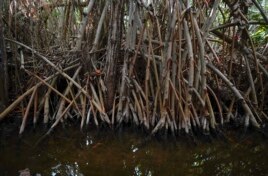10 November 2021
As leaders meet in Scotland for the United Nations conference on climate change, a real time battle to defend Mexican forestland continues.
There, on the Yucatan Peninsula, people are working to protect and expand mangrove forests. The low trees grow in watery areas near ocean coasts. They provide a defensive shelter from dangers like big storms. They also capture carbon dioxide, the main waste gas that drives Earth's rising temperature.
Years ago, mangroves were all along the Yucatan shores. Today, there are few.
A team of villagers from the area is trying to renew the forests. Scientists and donations support the effort. The Mexican government helps pay training costs of the team.
The villagers joined the renewal effort more than 10 years ago with scientist Jorge Alfredo Herrera, of the Center for Research and Advanced Studies of the Mexican Polytechnic Institute in Yucatan. He told them the mangroves needed a network of connected canals where fresh and salt water could mix.
The dig was going to be hard work and the pay was only four dollars a day. A group of women from Chelem, a fishing village, took the jobs, believing they could make substantial gains with little money.
Recently, after a heavy rainy season, the workers finished the second part of the process: planting young mangroves near the city.
They placed 20-inch mangrove seeds into small hills of mud, creating islands about a meter square in size.
"The happiest day is when our plants take," said 41-year-old Keila Vázquez. "They are like our children."

A tangle of mangrove roots grow alongside a shore in San Crisanto, near Progreso, in Mexico's Yucatan Peninsula, Friday, Oct. 8, 2021. (AP Photo/Eduardo Verdugo)
Global threat to mangroves
This mangrove renewal effort is similar to others around the world. Scientists and community groups are increasingly recognizing the need to protect and bring back the forests.
"Mangroves represent a very important ecosystem to fight climate change," said Octavio Aburto. He is a marine biologist at Scripps Institution of Oceanography in San Diego, California.
While the tropical trees only grow on less than 1 percent of the Earth's land, he said, "They can bury around five times more carbon in the sediment than a tropical rain forest."
Yet, around the world, mangroves are being destroyed. From 1980 to 2005, as much as 35 percent of the world's mangroves disappeared, says the U.N. Food and Agriculture Organization.
In Mexico, as in much of the world, development is the main threat to mangrove existence. The area of Cancun, a popular vacation place, lost most of its mangroves to roads and hotels starting in the 1980s. Mangroves on the country's southern Pacific Ocean coast also have been cleared to make room for fish farms. Oil industry operations in waters off the Gulf of Mexico threaten mangroves there too, said Aburto.
Mexico started to protect its mangroves in the 1980s. Mexico took steps to create a climate action plan in 1998 and was one of the first developing countries to sign on to the Paris Climate Accord. But Julia Carabias of the National Autonomous University of Mexico says the country's government has been reducing its support recently. Carabias says resources for environmental protection were cut by 60 percent in the past six years.
Efforts to save mangroves
There have been restoration efforts around the world to protect mangroves.
In 2020, the Indonesian government set a target of planting mangroves on more than 600 hectares of coastline by 2024. Government agencies are involved in renewal efforts that include community outreach and education.
But there have been some problems. Data on mangroves is hard to gather and exact maps are few. Also, powerful waves have pulled some newly planted mangroves out to sea. And COVID-19 has slowed community outreach and education efforts.
In Mexico, the successes have arrived slowly.
Manuel González is a 57-year-old fisherman. He helped regrow many mangroves in the community of Dzilam de Bravo, about 97 kilometers east of Progreso. Some trees are already 9 meters tall.
A powerful storm destroyed much of the area in 2002. Now, after 10 years of work, 120 hectares of mangroves are renewed. González says the storms do not cause as much damage to the community as a result. And, he adds, the fish and wildlife have returned.
But the mangroves face a new threat.
"In 10 years, you have a very nice mangrove for someone with a chainsaw to come and take it," González said. "That's something that hurts me a lot."
I'm Dan Novak.
And I'm Dan Friedell.
The Associated Press reported this story. Dan Novak adapted it for VOA Learning English. Caty Weaver was the editor.
_______________________________________
Words in This Story
canal — n. a long narrow place that is filled with water and was created by people so that boats could pass through it or to supply fields, crops, etc., with water
tropical — adj. of, relating to, occurring in, or used in the tropics
sediment — n. material that sinks to the bottom of a liquid
chainsaw — n. a tool that cuts wood with a circular chain that is driven by a motor and made up of many connected sharp metal teeth